Calcium Channel Blocker Market Size and Share
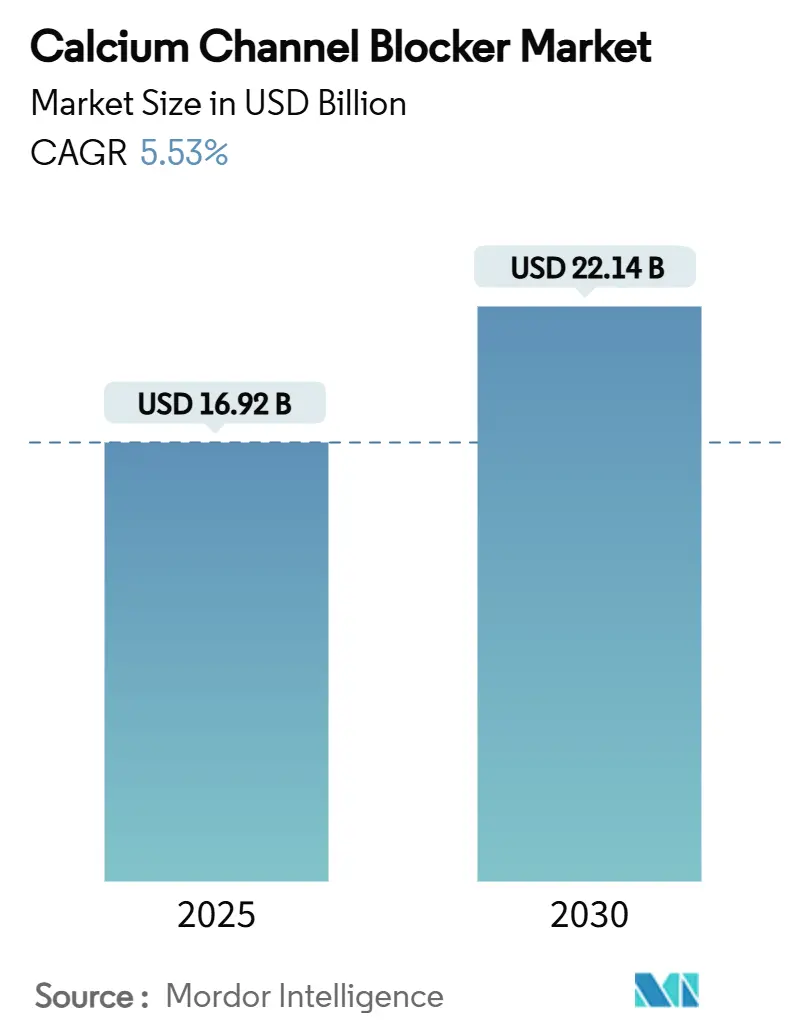
Calcium Channel Blocker Market Analysis by Mordor Intelligence
The calcium channel blocker market size stood at USD 16.92 billion in 2025 and is forecast to reach USD 22.14 billion in 2030, translating into a 5.53% CAGR across the period under review. Demand continues to gain momentum because hypertension remains the most prevalent modifiable cardiovascular risk factor, the global population is aging, and combination tablets that simplify daily regimens are now standard in first-line therapy. Solid clinical evidence supports the class’s cerebrovascular protective effect, while fourth-generation agents that block multiple channel subtypes extend the therapeutic envelope. Companies are also benefitting from smoother generic entry in price‐sensitive economies, fresh fixed-dose approvals in the United States and Europe, and region-wide initiatives that expand reimbursement for chronic cardiovascular medicines. At the same time, manufacturers must manage tighter impurity limits, episodic active pharmaceutical ingredient (API) shortages, and intensifying competition from SGLT2 inhibitors and endothelin antagonists, all of which shape pricing and portfolio decisions.
Key Report Takeaways
- By drug class, dihydropyridines led with 62.34% of the calcium channel blocker market share in 2024, while non-dihydropyridines posted the fastest 7.54% CAGR through 2030.
- By indication, hypertension held 71.32% of the calcium channel blocker market size in 2024, whereas neurological disorders are projected to grow at 8.23% CAGR between 2025-2030.
- By formulation, extended-release tablets dominated with 54.34% revenue in 2024; fixed-dose combinations are expanding at 7.78% CAGR to 2030.
- By distribution channel, retail pharmacies captured 46.32% in 2024, and hospital pharmacies are accelerating at 8.54% CAGR through 2030.
- By geography, North America commanded 39.54% regional revenue in 2024; Asia-Pacific is advancing at a 6.45% CAGR from 2025-2030.
Global Calcium Channel Blocker Market Trends and Insights
Driver Impact Analysis
| Driver | % Impact on CAGR Forecast | Geographic Relevance | Impact Timeline |
|---|---|---|---|
| Rising prevalence of hypertension and cardiovascular disorders | +1.8% | Global; highest in Asia-Pacific and emerging markets | Long term (≥ 4 years) |
| Growing geriatric population demanding long-term antihypertensive therapy | +1.2% | North America, Europe, Japan | Long term (≥ 4 years) |
| Increasing availability of affordable generic formulations | +0.9% | Global; strongest in price-sensitive markets | Medium term (2-4 years) |
| Expanding use of fixed-dose combination therapies to improve compliance | +0.8% | North America, Europe, global adoption | Medium term (2-4 years) |
| Emerging clinical evidence supporting neuroprotective applications | +0.4% | Developed markets | Long term (≥ 4 years) |
| Government initiatives for universal health coverage in emerging markets | +0.6% | Asia-Pacific, Latin America, Middle East & Africa | Medium term (2-4 years) |
| Source: Mordor Intelligence | |||
Growing Geriatric Population Demanding Long-Term Antihypertensive Therapy
The proportion of adults aged ≥ 65 years rose to 11% globally in 2024 and is climbing fastest in Japan and Southern Europe. Stroke risk doubles every decade after 55, and calcium channel blockers demonstrate durable protection without compromising renal function. A real-world study that followed 714,000 hypertensive seniors for 2.5 years linked continuous amlodipine therapy to lower dementia incidence relative to non-users. These overlapping cardiovascular and cognitive benefits encourage geriatricians to prioritize once-daily dihydropyridines in complex polypharmacy regimens, strengthening the growth trajectory of the calcium channel blocker market.
Increasing Availability of Affordable Generic Formulations
Amlodipine lost exclusivity in most territories years ago, shaving up to 70% off treatment costs and widening access among low-income patients. India and China now account for a majority of global API output, yet freight disruptions in 2025 briefly pushed ex-works prices up by double digits. Despite episodic volatility, therapeutic equivalence studies confirm that generic amlodipine delivers identical blood-pressure control, reassuring clinicians and supporting high substitution rates. Margin pressure from generics prompts originators to defend share through lifecycle strategies such as polypill launches and controlled-release reformulations.
Expanding Use of Fixed-Dose Combination Therapies to Improve Compliance
Four-in-ten treated hypertensive patients still fail to reach target blood pressure, driving the pivot toward fixed-dose combinations that merge complementary mechanisms in one tablet. The landmark ACCOMPLISH trial proved that pairing an ACE inhibitor with a dihydropyridine cut cardiovascular events more than a traditional ACE-diuretic pairing. Current guidelines in Europe and the United States now recommend initiating therapy with a two-drug combination in most patients, widening the commercial runway for products such as azilsartan-amlodipine, which posts the highest odds of blood-pressure response in network meta-analyses[1]Fadila Tahir et al., “Long-Term Amlodipine and Dementia Risk,” Journal of Hypertension, JHYPERTENSION.COM. These dynamics keep the calcium channel blocker market relevant even as newer classes capture headlines.
Emerging Clinical Evidence Supporting Neuroprotective Applications
Dihydropyridines that cross the blood-brain barrier are under evaluation for migraine prophylaxis, Parkinson’s disease risk reduction, and cerebral vasospasm prevention after subarachnoid hemorrhage. A 2024 systematic review linked chronic use to a statistically significant decrease in Parkinson’s incidence. Migraine trials using flunarizine and lomerizine show durable aura suppression, while verapamil retains a niche role in cluster headache. These exploratory indications enlarge the total addressable patient cohort and diversify revenue streams within the calcium channel blocker market.
Restraints Impact Analysis
| Restraints Impact Analysis | (~) % Impact on CAGR Forecast | Geographic Relevance | Impact Timeline |
|---|---|---|---|
| Stringent regulatory scrutiny over nitrosamine impurities | -0.8% | United States, European Union, global effect | Short term (≤ 2 years) |
| Adverse effect profile leading to therapy switches | -0.4% | Global; more pronounced in elderly populations | Medium term (2-4 years) |
| Supply chain vulnerabilities in active pharmaceutical ingredient sourcing | -0.6% | Global; China-dependent supply chains | Short term (≤ 2 years) |
| Competitive pressure from novel cardiovascular drug classes | -0.5% | Developed markets | Medium term (2-4 years) |
| Source: Mordor Intelligence | |||
Stringent Regulatory Scrutiny Over Nitrosamine Impurities
The US FDA’s 2024 guidance requires every manufacturer to map potential nitrosamine formation pathways, tighten specification limits, and validate mitigation steps before batch release. Similar expectations now apply across Europe and Japan. Compliance forces companies to upgrade analytical methods, vet excipient suppliers, and retrofit older facilities, elevating cost of goods. Voluntary suspensions during investigation phases have temporarily restricted supply, although most firms ultimately resume production once corrective actions satisfy regulators. The extra burden trims near-term profitability but is unlikely to derail the long-term trajectory of the calcium channel blocker market.
Supply Chain Vulnerabilities in Active Pharmaceutical Ingredient Sourcing
China’s 2023 Anti-Espionage Law heightened legal exposure for foreign auditors and customs brokers, prompting temporary pauses in on-site inspections and slowing batch clearance of cardiovascular APIs[2]Olivier Lantrès and Myriam Danziger, “China’s Anti-Espionage Law and Pharma Supply Chains,” Pharmaphorum, PHARMAPHORUM.COM. The ripple effect amplified lead times into Europe, where Germany briefly suspended certain audits over staff safety concerns. Simultaneous port congestion tightened supply of amlodipine besylate and raised spot-market prices. Geographic concentration remains a structural risk, but multinational firms are diversifying second-source vendors in India and Latin America to protect continuity, thereby stabilizing the calcium channel blocker market over the medium term.
Segment Analysis
By Drug Class: Dihydropyridines Maintain Therapeutic Dominance
Dihydropyridines held 62.34% of revenue in 2024, reflecting prescriber familiarity and once-daily convenience for drugs such as amlodipine, cilnidipine, and felodipine. The calcium channel blocker market size for this class is forecast to achieve mid-single-digit growth through 2030 as payers widen access to generics and physicians exploit vascular selectivity to avoid conduction disturbances. Uptake remains particularly strong in Asia-Pacific, where guideline committees often recommend amlodipine as the preferred starter drug for patients of any age group.
Non-dihydropyridines, comprising verapamil and diltiazem, are projected to post a 7.54% CAGR, outpacing the broader calcium channel blocker market. Their dual vascular and nodal activity makes them attractive in atrial tachyarrhythmias, postoperative rate control, and concomitant angina. Growth also benefits from research into N- and L-type dual inhibitors like cilnidipine that may reduce sympathetic overdrive in chronic kidney disease. Innovation therefore supports diversification without undermining the primacy of traditional dihydropyridines.
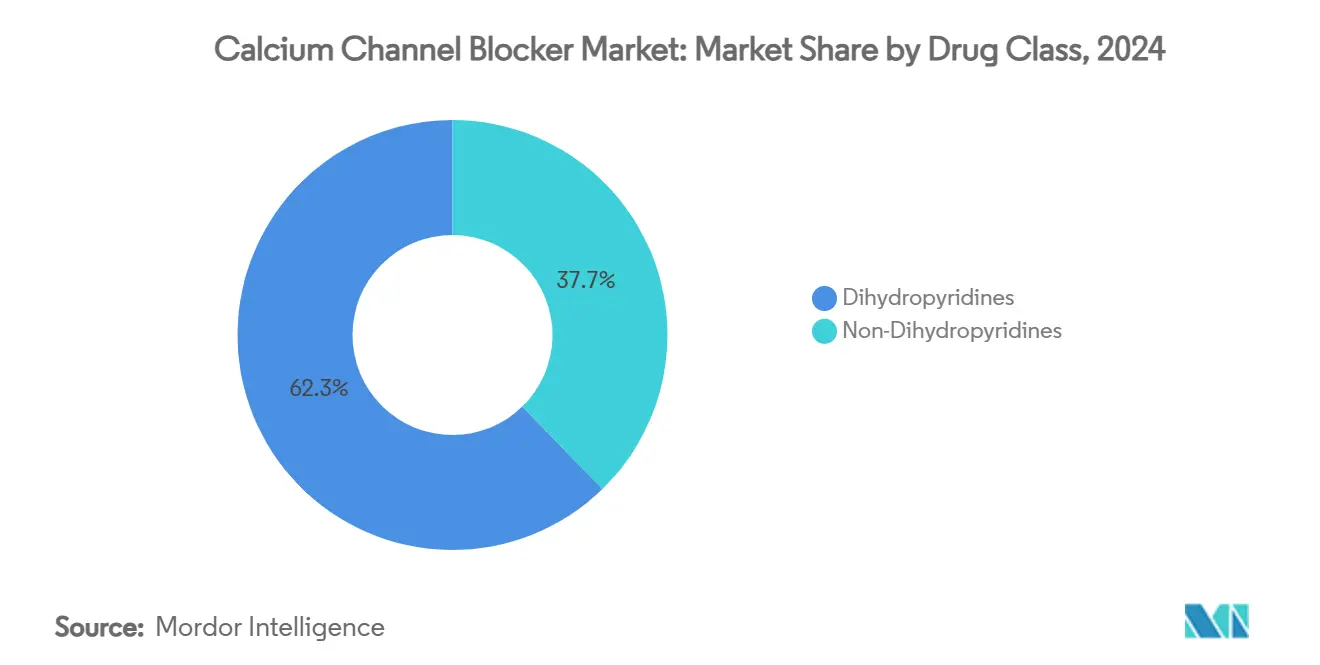
Note: Segment shares of all individual segments available upon report purchase
By Indication: Hypertension Leadership Faces Neurological Expansion
Hypertension accounted for 71.32% of 2024 prescriptions, preserving first-line status across North America, Europe, and most of Asia. Evidence that L-type blockade cuts stroke risk more than beta-blockade sustains confidence among primary-care physicians. In volume terms, the calcium channel blocker market size for hypertension should maintain a low-mid single-digit trajectory despite therapeutic inertia and guideline updates that encourage starting two agents at once.
Neurological disorders are on track to expand at an 8.23% CAGR to 2030, the highest among all use cases. Real-world analyses link chronic exposure to a 20% lower Parkinson’s disease incidence, and randomised trials are evaluating verapamil for cluster headache and cilnidipine for neurogenic hypertension. Small but growing off-label demand therefore provides an incremental avenue of diversification within the calcium channel blocker market.
By Formulation: Extended-Release Dominance Meets Combination Innovation
Extended-release formulations delivered 54.34% of 2024 revenue thanks to 24-hour pharmacokinetics that limit blood-pressure variability and simplify dosing schedules. Improved adherence translates into lower stroke recurrence rates, reinforcing physician preference for controlled-release designs in chronic care pathways.
Fixed-dose combinations are projected to grow 7.78% annually, the fastest among all dosage forms. Newer triple-ingredient tablets that merge amlodipine with telmisartan and chlorthalidone reduce pill burden from three to one, a benefit that resonates with value-based care mandates in North America and Europe. Early registrational data also suggest cost-effectiveness advantages when measured against traditional stepped therapy models, enlarging the addressable share of the calcium channel blocker market.
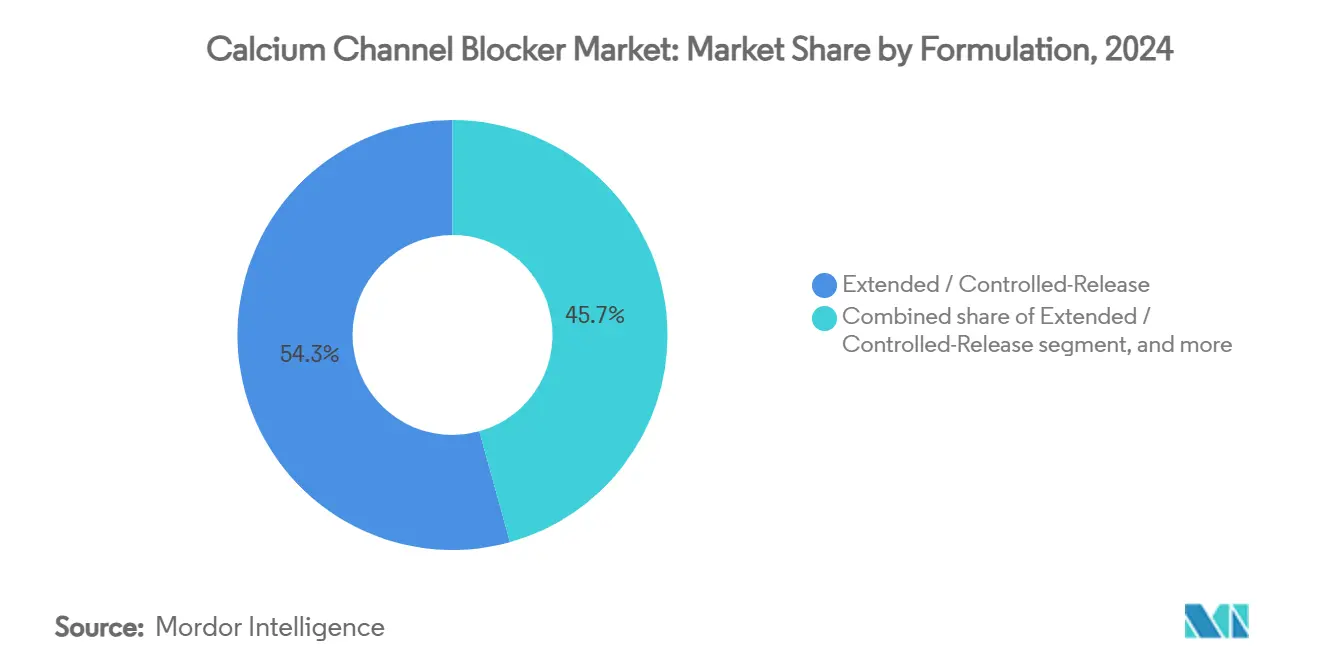
Note: Segment shares of all individual segments available upon report purchase
By Distribution Channel: Retail Pharmacy Accessibility Drives Hospital Growth
Retail pharmacies dispensed 46.32% of global volume in 2024 because most patients initiate therapy in primary care and continue lifelong maintenance. Generic substitution policies and predictable refills underpin channel stability.
Hospital pharmacies are forecast to post an 8.54% CAGR as cardiovascular case acuity rises. Intravenous nicardipine for perioperative blood-pressure control and diltiazem for rate-limiting rapid atrial fibrillation remain staples in critical-care formularies. Intensified monitoring for calcium channel blocker toxicity, including extracorporeal membrane oxygenation readiness, further drives hospital demand, supporting revenue upside beyond ambulatory settings.
Geography Analysis
North America retained 39.54% of global turnover in 2024 on the back of high insurance coverage and rapid adoption of novel polypills. Prescription audits show that calcium channel blocker use among Black patients jumped 41% between 2018-2019 compared with earlier years after the JNC 8 committee advocated the class as first-line therapy. Generic intensification offsets price erosion, while brand extensions like once-weekly patches attract niche cohorts with adherence challenges. Continuous medical education reinforces class familiarity, cushioning the calcium channel blocker market from short-term competition.
Europe ranked second, characterized by cost-containment and proactive safety surveillance. Class 2 recalls for amlodipine tablets in early 2025 underscored the region’s vigilance in microbial quality management[3]Medicines and Healthcare products Regulatory Agency, “Class 2 Medicines Recall,” GOV.UK. Health technology appraisal agencies such as NICE routinely favour low-priced generics but still reimburse branded combinations when economic models demonstrate fewer cardiovascular events. The advent of nifedipine-lidocaine ointment for chronic anal fissure adds a novel non-cardiac dimension, diversifying regional demand.
Asia-Pacific remains the fastest-growing territory at 6.45% CAGR. The twin forces of epidemiological transition and public insurance expansion elevate annual prescription volumes. Local firms in China and India supply competitively priced APIs and finished doses, ensuring affordability. Observational studies across 12 countries confirm that calcium channel blockers constitute the most frequently prescribed antihypertensive class, although intra-regional heterogeneity persists. Government bulk-purchase schemes continue to widen patient reach, supplying structural growth to the calcium channel blocker market.
Elsewhere, Latin America and the Middle East & Africa record steady uptake as urbanization increases cardiovascular risk. International donor programs that supply essential antihypertensive drugs to remote clinics enlarge the still-small baseline, contributing additional incremental units.
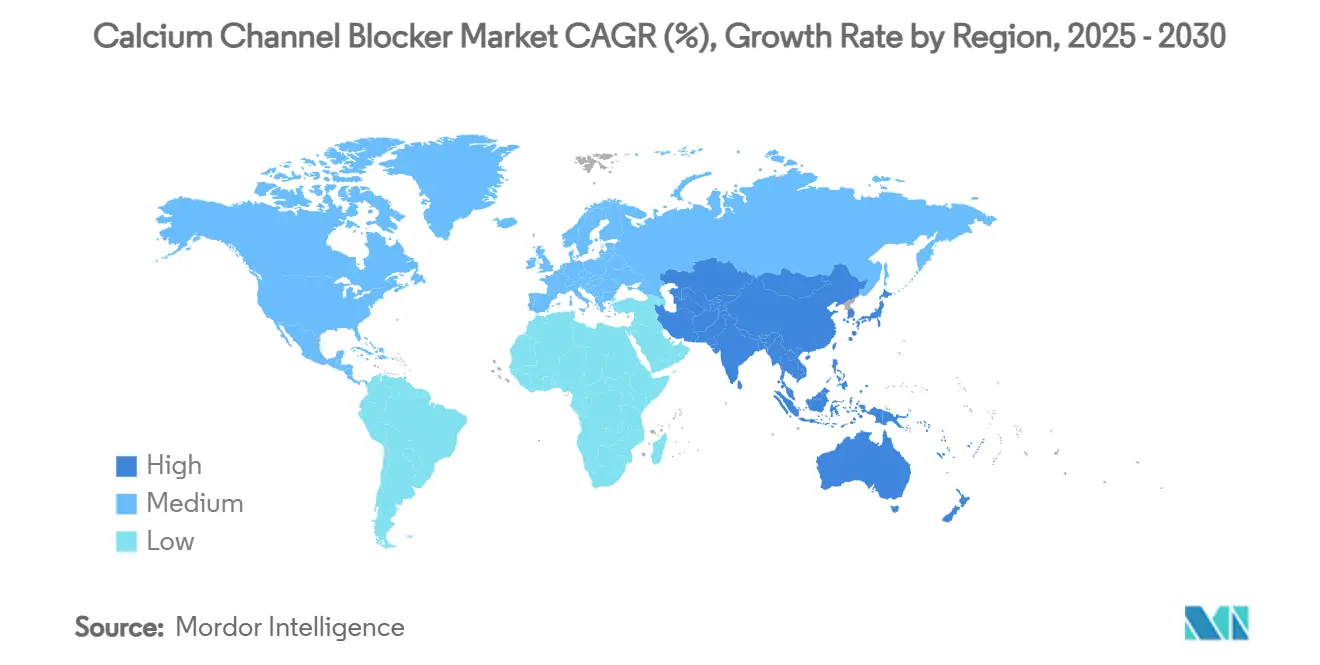
Competitive Landscape
The calcium channel blocker market is moderately fragmented. Pfizer, Novartis, Teva, and Viatris together distribute branded and unbranded products across more than 100 countries, while Indian manufacturers such as Sun Pharma and Dr. Reddy’s leverage cost efficiencies to penetrate tender markets. Combined, the five largest suppliers hold an estimated 28-30% share, leaving ample room for regional generics.
Strategic focus rests on lifecycle management—new particle sizes, gastro-retentive matrices, and fixed-dose combinations—that protect value in mature molecules. Pfizer reinforced its position by rolling out an amlodipine-rosuvastatin-telmisartan triple pill in the European Union during 2025 approvals. Novartis and Orion collaborate on verapamil micro-bead technology to curb constipation by shifting release to the distal small bowel, with Phase III read-out expected in 2026.
Chinese contract development and manufacturing organizations (CDMOs) are expanding vertically into finished product marketing, heightening competitive flux in Asia and Africa. Compliance with US FDA nitrosamine guidelines has become a key differentiator; facilities that secure clean inspection records gain a volume edge in export tenders. Meanwhile, biopharma entrants explore L-type channel blockade in orphan indications such as systemic sclerosis, signalling niche innovation pathways that diversify the calcium channel blocker market.
Calcium Channel Blocker Industry Leaders
-
Pfizer Inc.
-
Viatris Inc.
-
Teva Pharmaceutical Industries Ltd.
-
Sun Pharma Industries Ltd.
-
Novartis AG
- *Disclaimer: Major Players sorted in no particular order
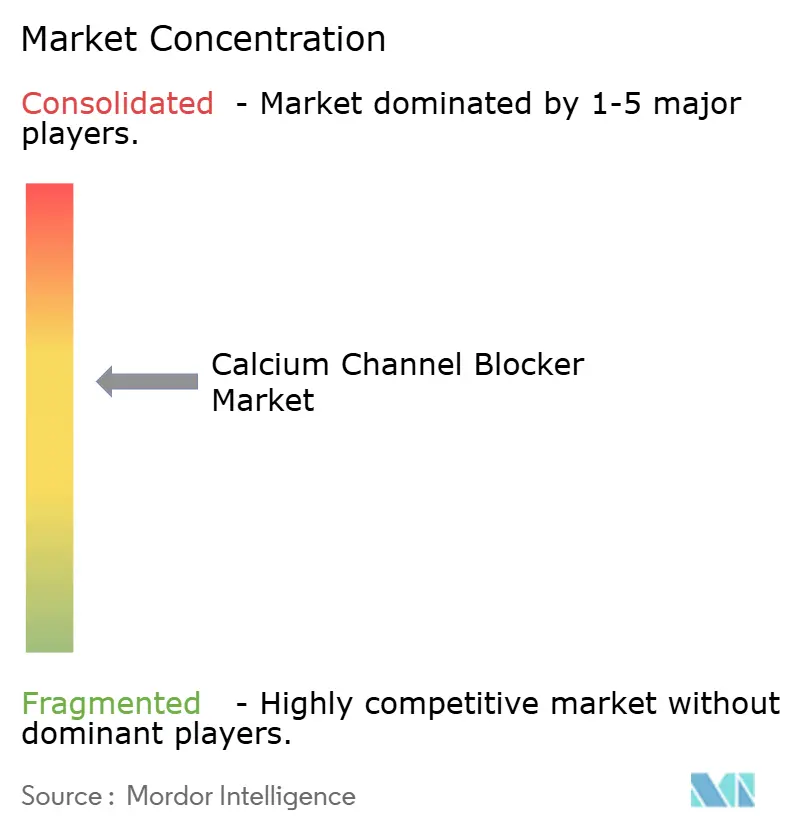
Recent Industry Developments
- March 2025: Milestone Pharmaceuticals’ fast-acting nasal diltiazem, Etripamil (Cardamyst), is under FDA review for paroxysmal supraventricular tachycardia after Phase 3 RAPID success.
- February 2025: MHRA issued a Class 2 recall for four amlodipine batches due to microbial contamination, spotlighting ongoing generic quality assurance imperatives.
- September 2024: Cilnidipine analogue AISA-021 received orphan drug status for systemic sclerosis, broadening non-cardiac opportunity spaces.
- July 2024: FDA denied Novartis’ petition to block Entresto generics, indirectly influencing future combination strategies that may include calcium channel blocker components.
- June 2024: FDA cleared Tryvio (aprocitentan) for resistant hypertension, setting a new benchmark comparator for future multidrug regimens.
Global Calcium Channel Blocker Market Report Scope
As per the scope, calcium channel blockers/ calcium antagonists are drugs that are used against indications such as hypertension and chest pain. It slows the calcium movement that helps to widen the blood vessels and makes it easier for the heart to pump blood. The Calcium Channel Blocker Market is Segmented By Drug Class (Dihydropyridine, Benzothizepine, Phenylalkylamine), Distribution Channel (Hospitals, Retail Pharmacies, and Other Distribution Channels), and Geography (North America, Europe, Asia-Pacific, Middle-East and Africa, and South America). The market report also covers the estimated market sizes and trends for 17 different countries across major regions globally. The report offers the value (in USD million) for the above segments.
| Dihydropyridines | Amlodipine |
| Nifedipine | |
| Felodipine & Others | |
| Non-Dihydropyridines | Phenylalkylamine (Verapamil) |
| Benzothiazepine (Diltiazem) |
| Hypertension |
| Angina Pectoris |
| Arrhythmia |
| Raynaud's Phenomenon |
| Neurological Disorders (Migraine, SAH) |
| Other Indications |
| Immediate-Release |
| Extended / Controlled-Release |
| Fixed-Dose Combinations |
| Hospital Pharmacies |
| Retail Pharmacies |
| Other Distribution Channels |
| North America | United States |
| Canada | |
| Mexico | |
| Europe | Germany |
| United Kingdom | |
| France | |
| Italy | |
| Spain | |
| Rest of Europe | |
| Asia-Pacific | China |
| Japan | |
| India | |
| Australia | |
| South Korea | |
| Rest of Asia-Pacific | |
| Middle East & Africa | GCC |
| South Africa | |
| Rest of Middle East & Africa | |
| South America | Brazil |
| Argentina | |
| Rest of South America |
| By Drug Class | Dihydropyridines | Amlodipine |
| Nifedipine | ||
| Felodipine & Others | ||
| Non-Dihydropyridines | Phenylalkylamine (Verapamil) | |
| Benzothiazepine (Diltiazem) | ||
| By Indication | Hypertension | |
| Angina Pectoris | ||
| Arrhythmia | ||
| Raynaud's Phenomenon | ||
| Neurological Disorders (Migraine, SAH) | ||
| Other Indications | ||
| By Formulation | Immediate-Release | |
| Extended / Controlled-Release | ||
| Fixed-Dose Combinations | ||
| By Distribution Channel | Hospital Pharmacies | |
| Retail Pharmacies | ||
| Other Distribution Channels | ||
| Geography | North America | United States |
| Canada | ||
| Mexico | ||
| Europe | Germany | |
| United Kingdom | ||
| France | ||
| Italy | ||
| Spain | ||
| Rest of Europe | ||
| Asia-Pacific | China | |
| Japan | ||
| India | ||
| Australia | ||
| South Korea | ||
| Rest of Asia-Pacific | ||
| Middle East & Africa | GCC | |
| South Africa | ||
| Rest of Middle East & Africa | ||
| South America | Brazil | |
| Argentina | ||
| Rest of South America | ||
Key Questions Answered in the Report
What is the current value of the calcium channel blocker market?
The calcium channel blocker market size is USD 16.92 billion in 2025 and is forecast to climb to USD 22.14 billion by 2030.
Which drug class dominates sales?
Dihydropyridines, led by amlodipine, captured 62.34% of 2024 sales and maintain a steady lead through 2030.
Which region is expanding the fastest?
Asia-Pacific is projected to post a 6.45% CAGR from 2025-2030 on the back of broader insurance coverage and a rising cardiovascular disease burden.
How significant are fixed-dose combinations?
Fixed-dose combinations form the quickest-growing formulation segment with a 7.78% CAGR as they improve patient adherence and cardiovascular outcomes.
What regulatory issue currently affects manufacturers?
Global agencies are enforcing stricter limits on nitrosamine impurities, prompting costly analytical upgrades and temporary batch suspensions.
Are calcium channel blockers being explored beyond cardiovascular diseases?
Yes, ongoing studies examine neuroprotective roles in migraine and ParkinsonÕs disease, while cilnidipine analogue AISA-021 is in development for systemic sclerosis.
Page last updated on:



